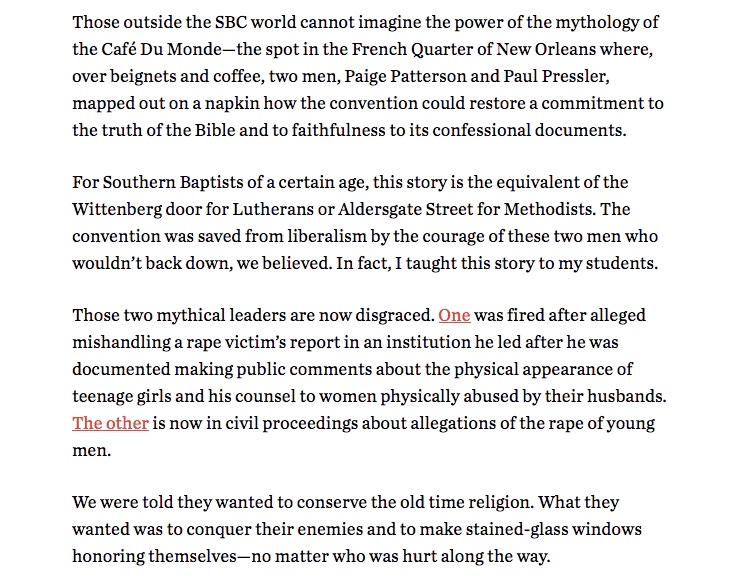I don’t recall the specific date in late summer 1985—but I remember exactly where I was standing. In the sunshine, near the windows in the library of Gordon-Conwell Theological Seminary. I was pulling Gustaf Aulén’s Christus Victor from the shelves when my favorite theology professor approached me.
We chatted briefly, and then he asked, “Do you know what’s going on in the Southern Baptist Convention?” He was holding a recent copy of Christianity Today. He pointed to a news story in the open magazine.
I was from California, not exactly Southern Baptist territory. But I knew a little. A surprising number of my classmates at this Massachusetts seminary were from North Carolina and Georgia. And they talked incessantly about the “fundamentalist takeover” of their denomination. The Southern Baptists had just held their annual national meeting. They’d elected another fundamentalist president and defeated a bid by SBC moderates to regain their voice in the church. It was big news and would later be seen as a “watershed moment” in the SBC.
“A bit,” I confessed. Everybody knew about the takeover. For about a decade, Southern Baptist fundamentalists had engineered an institutional and theological political effort to eliminate moderates and liberals from church leadership, Baptist colleges and seminaries, and all SBC organizations. They’d been relentless—and successful.
“Since you’re going to be studying American religion in graduate school, this news is important.” He paused, and then said with a particularly gleeful emphasis:
“It is the first time in history that conservatives have ever succeeded in turning back liberalism in a major denomination. Every conservative—every evangelical—who wants to return their church to orthodoxy needs to understand and imitate what they are doing. We should all ‘be’ Southern Baptists now.”
And then he smiled—perhaps the most malevolent smile I’ve ever seen.
It was almost as if he predicted the next thirty years of American Protestantism.
* * *
If 1985 was the SBC’s watershed, May 22, 2022 marks what former Southern Baptist leader Russell Moore angrily called “the Southern Baptist apocalypse.”
Moore’s essay includes a nostalgic memory of the history of the Southern Baptist takeover—“the convention was saved from liberalism.” This is the key passage:

The Patterson-Pressler meeting happened in 1967, and in the decades that followed, the two men hatched a plan to unify Southern Baptists conservatives and manipulate institutional procedures to take over America’s largest Protestant denomination. It was brash—and it was a long game. Of this history, Jonathan Merritt wrote in The Atlantic:
The two men successfully executed their strategy in the subsequent decades, a movement they labeled the “Conservative Resurgence” and their opponents dubbed the “Fundamentalist Takeover.” Whatever one calls it, the result was a purging of moderates from among denominational ranks, the codifying of literal interpretations of the Bible, and the transformation of the Southern Baptist Convention into a powerful ally of the Republican Party.
It was a massive victory in both church and state—and it had consequences in American history that are still yet to unfold. No wonder the Café du Monde episode achieved mythic status for conservative Southern Baptists like Russell Moore. No fundamentalists had ever managed to do what they’d done: win it all. They turned back the theological and social clock in a huge denomination and they turned their church into the most significant power broker in the Republican party.
While I appreciate Mr. Moore’s wrestling with the Southern Baptist Convention in the last few years, and, in particular grappling with this originating myth, it is necessary to point out that Patterson and Pressler never intended to “save” anything.
Except one thing: male power—their authority—as absolute leaders in church and state.
It was always about exerting control—especially about controlling women.
And there’s nothing mythological about that.
It is the way patriarchy always works.
* * *
Southern Baptists may like the myth about saving their church from liberalism. But there’s something Baptists don’t like: creeds.
Oddly enough, a “creed” plays a central role in this story of the Fundamentalist takeover of the Southern Baptist Convention.
Since their beginnings in the 17th century, Baptists have emphasized freedom of conscience, personal experience, and separation of church and state. In the 1600s, established religious leaders—especially Calvinists and Anglicans—worried that the Baptists’ radical passion for soul liberty would upset God’s design of male leadership in government, church, and family. And the Baptists did nothing to assuage such fears, especially as their ideals helped fuel democratic revolutions in both England and the American colonies.
The Baptist commitment to liberty also shaped a revolution among Christian women—empowering them to exercise their spiritual gifts and take up leadership in the emerging religious movement. Indeed, one of the first attacks leveled at Baptists in England was that they scandalously allowed for “she-preachers,” including one Mrs. Attaway, whose Tuesday afternoon Bible lectures in 1645 attracted as many as a thousand eager listeners (Mrs. Attaway sounds like Beth Moore’s foremother!). Baptist women were among the greatest radicals of a revolutionary century—and they preached a gospel of visionary egalitarianism based in biblical injections like “your daughters will prophesy” and “there is no longer male and female in Christ Jesus.”
Critics of these women—the collared divines trained in universities—saw a connection between democratic revolution and female radicalism. According to one contemporary pamphlet, the women preachers:
have lately advanced themselves with vain-glorious arrogance, to preach in mixed congregations of men and women, in an insolent way, so usurping authority over men, and assuming a calling unwarranted by the word of God for women to use: yet all under the colour, that they all as the Spirit moves them; wherein they highly wrong and abuse the motions of the blessed Spirit, to make him to be the author of so much schism, disorder, and confusion; they being rather led by the strong delusions of the prince of darkness, to countenance their ignorance, pride, and vain-glory.
Radical women meant disordered society; only a chaotic society would permit such ungodly women to “usurp authority over men.” The only solution was to quote scripture back to women—texts about women being silent, not holding authority, and the call for wives to submit to their husbands—and to put them in jail.
Baptist radicalism didn’t get too far in England—a world tightly controlled by the Church of England—but it took root in the fertile spiritual soil of England’s American settlements. In the colonies (and later in the United States), the Baptists kept their egalitarian edge with women, the poor, and the enslaved—those whose souls longed for genuine liberty—and navigated its outsider status to become one of the most dominant forms of Protestantism in the majority Protestant young nation.
But Baptist success would eventually mean Baptist compromise. And compromise Baptists did, especially in the South, where, as they became richer, socially respectable, and politically influential, Baptist men adopted the hierarchy of privilege of their Anglican overlords, a hierarchy of gender, status, and race based on a biblical passage in Ephesians: Men as the head of state, church, and family; women as submissive (but not equal) partners; children as obedient offspring; and slaves as dutiful possessions of their masters.
Thus, Baptists in the American South eventually became Southern Baptists—a denomination where a culture of southern patriarchy and deference prevailed. That culture had originated in Anglican prerogative and entitlement, and it was not native to Baptists’ own egalitarian religious movement. Yet, hierarchy reshaped the very meaning and practice of being Baptist, and it displaced spiritual freedom by replacing it with a profound commitment—a sacred duty really—to submission and enslavement.
Perhaps not surprisingly, Baptist leaders continued to insist that they were a “non-hierarchical” association (no creeds! no bishops! no liturgies!) even while they moved toward ever-more rigid forms of patriarchy and racial superiority. We all like to believe we are faithful stewards of the tradition we inherit, even when we’re not.
As an aspect of their stated dislike of hierarchy, Southern Baptists would not write creeds, but they would develop an outline of faith—a statement called Baptist Faith and Message, a kind of “non-creed” creed. The first version was issued in 1925 during the heyday of the Fundamentalist-Modernist crisis. A 1963 revision toned down the fundamentalism of the older statement, articulating more strongly Baptist latitude in doctrine that favored the liberty of conscience. Eventually, Southern Baptist hardliners—like Patterson and Pressler of Russell Moore’s mythology narrative—would define latitude as liberalism. They’d see the 1963 statement as problematic, a kind of open door toward a less biblical church. In the late 1970s, they launched a crusade to change it. And that would involve taking over the denomination.
Among their first targets were women—the Baptist women in ministry (by 1987, approximately 500 women had been ordained in the SBC) and, most especially, women in the home. Southern Baptist fundamentalists busied themselves by creating an entire movement called “complementarianism,” a theological doctrine of equal-but-separate sexes based in the “joyful submission” of wives and the restriction of female authority. In 1998, they succeeded in adding a new article to Baptist Faith and Message on the theology of the family:
The husband and wife are of equal worth before God, since both are created in God’s image. The marriage relationship models the way God relates to His people. A husband is to love his wife as Christ loved the church. He has the God-given responsibility to provide for, to protect, and to lead his family. A wife is to submit herself graciously to the servant leadership of her husband even as the church willingly submits to the headship of Christ.
They enshrined hierarchy and patriarchy in their non-creed creed, making “headship” and wifely “gracious” submission the heart of Southern Baptist faith.
The fallout was swift. Moderates left the Southern Baptist Convention and formed a separate denomination. Trusted PBS journalist Bill Moyers called the conservatives “theological Stalinists” and former President Jimmy Carter renounced his association with the church. Carter would later explain that he left because of the SBC’s views on women:
At its most repugnant, the belief that women must be subjugated to the wishes of men excuses slavery, violence, forced prostitution, genital mutilation and national laws that omit rape as a crime. But it also costs many millions of girls and women control over their own bodies and lives, and continues to deny them fair access to education, health, employment and influence within their own communities.
But Patterson and Pressler were jubilant. They’d won. As if to seal the deal, in 2000, Paige Patterson (who has been implicated in the scandal) led 550 couples in a mass ceremony to renew their wedding vows where, “Wives reciprocated, in one accord, pledging to graciously submit and honor their husband’s role as servant leader while acknowledging their responsibilities as wife and mother ‘as priority above all else except God.’”
“We are convinced that a denial or neglect of these principles,” according to a statement crafted and signed by many Southern Baptist leaders, “will lead to increasingly destructive consequences in our families, our churches, and the culture at large.”
If society is in trouble, blame the women. Every problem goes back to Eve, the sinner, the temptress. Bring the women in line, and the culture will be restored to its proper order.
The Southern Baptist Convention became exactly what Paige Patterson and Paul Pressler hoped it would be—and exactly what Bill Moyers and Jimmy Carter feared it would become.
The Southern Baptist sex scandal isn’t about a few flawed men. It isn’t about a lot of flawed men. It isn’t about flawed leadership or flawed policies. It is a “success” story of the theological vision and social structure that Patterson and Pressler planned.
I doubt they specifically planned abuse, since they always offered the codicil that their hierarchy depends on the clause, “as Christ loved the church.” But it wound up that way. Because physical and sexual abuse is a feature of the system. Religious hierarchy has always been used against women, and it has been used to diminish their status as human beings. Since Eve. Having been scapegoated for social sin, political disorder, and cultural change, women were targeted for dominance and control, complete with the imperative to submit—abuse is the only possible result.
This can’t be fixed or addressed without a theological revolution of inclusivity and egalitarianism—a revolution that the SBC rejected when it embraced the plan hatched at Café du Monde.
Put simply, the Southern Baptist Convention doesn’t just have a sexual abuse problem. It has a theological problem that generated a sexual abuse problem.*
I’m not sorry that Southern Baptist history has been demythologized. The story was the worst possible folk tale of the evil of liberal women preachers and the heroism of crusading male pastors.
There is, however, a myth that remains even after this horrible report. One that Russell Moore doesn’t seem to recognize: the myth of benign patriarchy.
Benign patriarchy doesn’t exist. Hierarchies—especially theological ones based in gender—always wind up oppressing and abusing someone. That isn’t a myth. It isn’t even a parable. This is a tragic, depressing, vile, and often repeated history. The Southern Baptist Convention has reminded us of all this. They didn’t save the church from liberalism. They subjected innocent people to a lifetime of suffering. They’ve sounded a warning of what happens when a body politic seeks to restore order by rebuilding a hierarchical pyramid of power. That’s a lesson we should all heed.
*A note: Liberal institutions also have problems with abuse—but those issues and patterns do not originate with the particular theological vision or interpretation of the Bible operative in the SBC. In liberal communities, abuse arises from different circumstances and can be mitigated by different guardrails and policies. Also, there are liberal hierarchical religious groups or organizations—“liberal” and “hierarchical” is a difficult, perhaps even contradictory, tension to maintain, especially regarding power and authority, that also can result in abuse.
This essay first appeared on The Cottage and is republished with the generous permission of the author.





